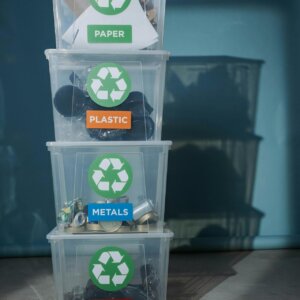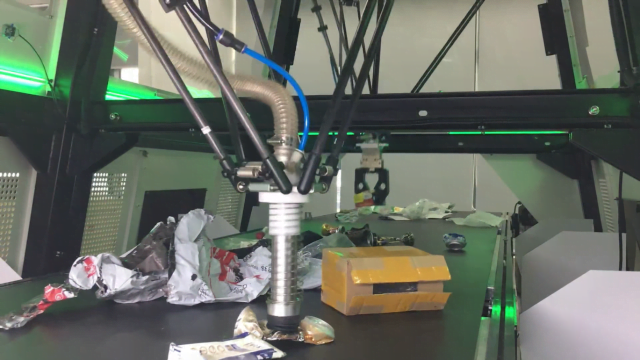- How does AI garbage sorting work?
- Working principle of AI garbage sorting robot
- Application of foreign artificial intelligence sorting robots
- Waste management significantly impacts the environment in several ways, both directly and indirectly:
- Consistency in AI garbage sorting is crucial for its effectiveness and reliability. Achieving consistent results involves several key elements:
The tireless artificial intelligence garbage sorting robot can accurately classify mixed garbage. The staff train the AI garbage sorting robot through big data, so that the robot has a judgment similar to that of the human brain, so as to quickly and accurately identify and classify waste, and finally liberate front-line workers from dirty and boring work.
A kind of robot with science fiction color has been actually used in domestic garbage sorting centers, so how does AI garbage sorting work?
AI garbage sorting Robots can work 24 hours a day continuously, twice as efficient as workers.
According to customer requirements, garbage sorting robots can divide waste of different items and materials into more than 20 kinds of recyclables such as PET, HDPE, PP, glass, Lile bags, cans, clothes, shoes, paper, etc. All this waste was originally sorted by workers, but now it can be completely handed over to artificial intelligence.
It is especially worth mentioning that intelligent sorting robots can also sort dense waste paper and other two-dimensional objects on the conveyor belt, and can even pick out impurities such as plastic bags and plastic film in the waste paper, which greatly improves the purity of waste paper.
Robots can sort more than 70 items per minute, about twice as fast as ordinary people. Robots can also work continuously for 7 days * 24 hours. Workers can’t withstand such intensive labor. With the help of these intelligent robots, we believe that it is entirely possible to achieve unmanned waste recycling in the future, thus solving the long standing shortage of personnel in garbage sorting centers and greatly reducing manual sorting errors caused by fatigue.
How does AI garbage sorting work?

Image Recognition: Cameras or sensors capture images of the waste as it moves along a conveyor belt or through the sorting system. These images provide visual data for the AI system.
Data Collection and Analysis: The AI system processes the images in real-time, using computer vision algorithms to analyze the visual data. It identifies different materials based on characteristics like shape, color, texture, or patterns.
Machine Learning: The system uses machine learning models trained on vast datasets to recognize and classify various types of materials. These models continually improve their accuracy through feedback mechanisms, learning from new data and adjustments made by operators.
Sorting Decision: Once the AI identifies the material, it directs actuators or robotic arms to sort the waste into designated bins or compartments. For instance, it might segregate plastics, paper, glass, metals, or other categories based on the identified material type.
Adaptability and Optimization: Advanced AI systems can adapt to changing conditions and new types of waste, continuously optimizing their sorting accuracy and efficiency. They can also adjust to variations in the appearance or condition of materials.
The key advantages of AI garbage sorting include:
Efficiency: AI garbage sorting systems can process vast amounts of waste quickly and accurately.
Consistency: They maintain a consistent level of sorting accuracy without fatigue or variability.
Improving Recycling Rates: By accurately sorting materials, they increase the efficiency of recycling processes and minimize contamination.
Overall, AI garbage sorting systems offer a promising solution to enhance waste management, increase recycling rates, and reduce the burden on landfills by efficiently sorting and diverting recyclable materials from general waste streams.
Working principle of AI garbage sorting robot
Taking Picking Ai, a product of Gongye Technology, a domestic garbage sorting robot company, as an example, it is understood that the working principle of this product includes the following points:
- Artificial intelligence algorithms train robots through massive images. Regardless of whether the waste is intact, dents, crushed, twisted, partially covered, etc., the robot can identify it, and accurately grab the materials to be recycled from the conveyor belt and put them into In the corresponding material frame. As long as the human eye can recognize at a glance, the artificial intelligence of arch and leaf technology can recognize it.
- The combination of artificial intelligence software and high-speed sorting robots, similar to the neural network system of the human brain and human hands, has the ability to recognize and execute.
- The artificial intelligence of bow leaf technology also has a strong migration learning ability, which can achieve data sharing and remote intelligence improvement through the cloud brain and robots deployed everywhere. For example, robots deployed in AI garbage sorting robot center can learn from different robots deployed throughout the country, and robots can also inherit the experience of waste identification.
Application of foreign artificial intelligence sorting robots
(1) BHS (United States)
Bulk Handling Systems (BHS) is located in Eugene, Oregon. In April 2019, BHS deployed nine intelligent sorting robots at the garbage collection center in Berkeley County, South Carolina, which is the largest single deployment site of BHS. The company has deployed a total of 84 robots in 10 countries to AI garbage sorting plastics, metals, paper and other recyclable waste, said Peter Raschio, marketing director. The company’s intelligent sorting robots cost about $200,000 per unit (the above data are from the network). At present, BHS intelligent sorting robot has not yet entered the Chinese market.
Key components and features of Bulk Handling Systems AI garbage sorting robot include:
- Conveyor Belts and Feeders: These systems use conveyors to transport bulk materials through the sorting process. Feeders help regulate the flow of materials onto the conveyor belts.
- Screening and Sorting Equipment: BHS typically involves a range of machinery for sorting materials. This may include trommels (cylindrical drum screens), screens, and separators that segregate materials based on size, shape, density, or other characteristics.
- Optical Sorting Technology: Some advanced BHS systems integrate optical sorting technology, using sensors and cameras to identify materials based on their visual properties such as color, shape, and texture.
- Magnetic Separators: Magnets are used to separate ferrous metals from non-ferrous metals and other materials. This helps in segregating metals efficiently.
- Robotic Sorting Systems: In some advanced BHS setups, robotic systems equipped with AI and computer vision technology are employed for precise material recognition and sorting.
- Control Systems and Automation: BHS often incorporates sophisticated control systems that automate the sorting process, adjusting machinery settings based on real-time data and optimizing the flow of materials through the system.
- Waste to Energy Integration: Some BHS setups are designed to extract energy from waste materials, contributing to energy generation through processes like waste incineration or gasification.
BHS systems play a crucial role in waste management and recycling industries by enabling efficient separation and processing of various materials. They help in diverting recyclable materials from landfills, reducing environmental impact, and maximizing the recovery of valuable resources. The integration of advanced technologies such as AI and robotics continues to enhance the efficiency and accuracy of these systems.
(2) AMP (United States)
AMP Robotics was founded in 2014, and the company also uses AI garbage sorting robot robots to execute its artificial intelligence algorithms. The most successful case is the SSR plant in Florida, USA, using 14 AMP intelligent sorting robots. In 2019, AMP Robotics announced the completion of round A financing of $16 million, led by Sequoia Capital (United States). Previously, AMP Robotics had been invested by BV Baidu Venture Capital Angel Round. AMP declined to disclose the price of its intelligent sorting robot (the above data is from the network). According to industry insiders, AMP has not yet entered the Chinese market.
Waste management significantly impacts the environment in several ways, both directly and indirectly:
- Landfills and Pollution: Improper waste disposal in landfills can lead to soil, air, and water pollution. Decomposing organic waste generates methane, a potent greenhouse gas that contributes to climate change. Leachate, a harmful liquid that forms as waste breaks down, can contaminate soil and groundwater, affecting ecosystems and human health.
- Air Pollution: Burning waste in open dumps or incineration without proper controls releases harmful gases and particulate matter into the air. These pollutants can cause respiratory issues, contribute to smog formation, and harm air quality.
- Resource Depletion: Improper waste management results in the inefficient use of resources. Recycling and proper disposal help conserve raw materials and reduce the need for resource extraction, preserving natural habitats and biodiversity.
- Water Contamination: Inadequate waste disposal methods can contaminate water sources. Leachate from landfills and improper disposal of hazardous materials can seep into groundwater or run off into rivers and oceans, impacting aquatic ecosystems and potentially affecting human health.
- Habitat Destruction: Improperly managed waste can harm wildlife and their habitats. Plastic waste, for instance, can entangle animals and cause harm when ingested, leading to injuries or death.
- Climate Change: The production, transportation, and disposal of waste contribute to greenhouse gas emissions. Methane from landfills, carbon dioxide from waste incineration, and energy intensive waste management processes all contribute to climate change.
Consistency in AI garbage sorting is crucial for its effectiveness and reliability. Achieving consistent results involves several key elements:
- Data Quality and Quantity: Training AI garbage sorting models for garbage sorting requires diverse and extensive datasets. High quality data that accurately represents various types, shapes, colors, and conditions of waste materials is essential. Consistency in the quality and quantity of training data directly impacts the AI model’s ability to make reliable sorting decisions.
- Robust Algorithms and Models: The AI garbage sorting algorithms and models used for garbage sorting need to be robust and reliable. They should be capable of handling variations in materials, lighting conditions, and environmental factors to consistently identify and sort waste accurately.
- Regular Model Maintenance and Updating: AI garbage sorting models need continuous monitoring and updating. Regular maintenance involves retraining models with new data to adapt to changing waste compositions and to improve accuracy and consistency over time.
- Calibration and Quality Control: Regular calibration and quality control checks ensure that the sensors, cameras, or other hardware components used in the sorting process remain accurate and consistent. This helps maintain the reliability of the input data for AI models.
- Standardization in Sorting Process: Standardizing the sorting process itself helps in achieving consistency. Ensuring uniformity in the setup, workflow, and parameters used in sorting waste materials can minimize variability and enhance consistency.
- Feedback Loops and Error Correction: Implementing feedback loops allows the system to learn from its mistakes. When errors occur in sorting, providing feedback to the AI model helps it improve and make more accurate decisions in the future.
- Monitoring and Performance Evaluation: Continuous monitoring of the sorting process and regular evaluation of the AI garbage sorting system’s performance are crucial. It helps identify inconsistencies or deviations, allowing for timely adjustments or improvements.
Consistency in AI garbage sorting is a continuous effort that involves a combination of technology, data quality, system calibration, and ongoing improvements. By addressing these aspects, developers and operators can ensure that the sorting process remains reliable and effective in handling various types of waste materials consistently.

